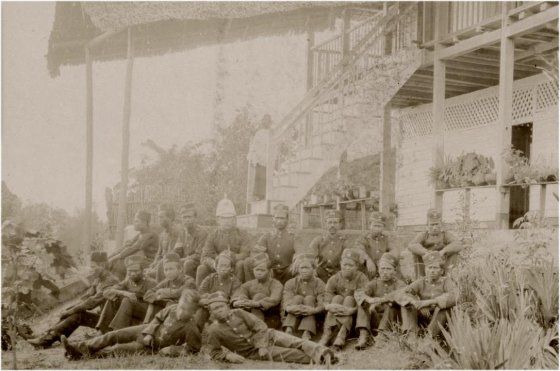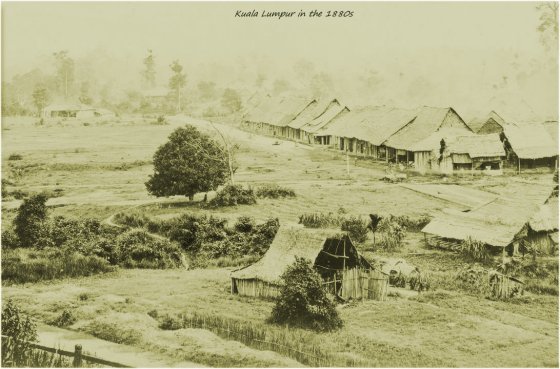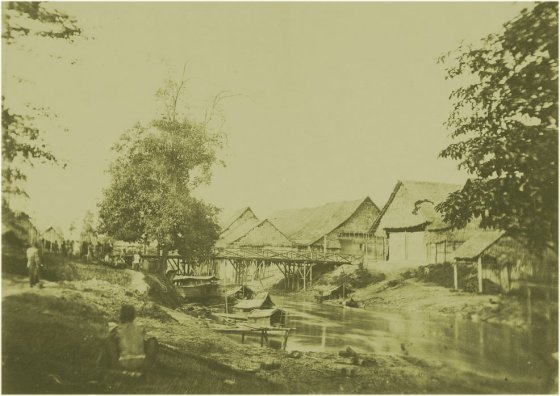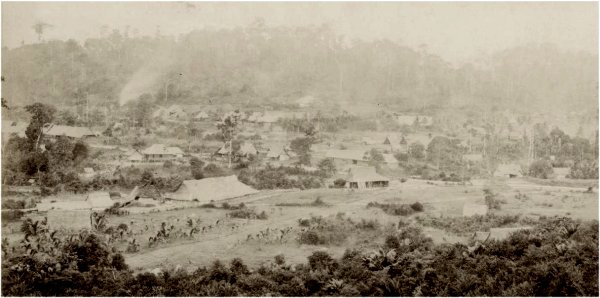|
|
The Battle for Kuala Lumpur
 Selangor Police and
European
officer, circa 1880.
Selangor Police and
European
officer, circa 1880.At the beginning of May 1872, Raja Asal and Raja Laut with a
force of 2,000 Malays marched from Kajang to Petaling Batu (what is
today modern Chan Sow Lin on the Sungai Besi Road) where they camped
and started constructing defensive stockades. This was just three miles
from Yap Ah Loy's camp. It was only at this point that Yap Ah Loy had
learned of Raja Asal's defection to the enemy. The bulk of Yap Ah Loy's
forces, together with his Malay allies under Imam Perang Mat Akil, were
up 35 miles to the north in Ulu Yam and Rawang - blocking any attack
from Syed Mashhor's forces in Ulu Selangor. At Kuala Lumpur, he only
had about 200 troops, including 80 sepoys and about 20 European and
Eurasian non-commissioned officers under the command of a Dutchman van
Hagen and an Italian, Cavalieri.
Yap Ah Loy very rapidly recruited more mine workers and local Chinese
to reinforce his forces in Kuala Lumpur. He placed 2,000 men under van
Hagen's command and ordered him to attack Raja Asal's forces in
Petaling Batu and destroy them before their stockades were completed.
Van Hagen's and Raja Asal's forces bitterly fought on a frontline just
beyond the Kwong Tong Chinese cemetery in Bukit Petaling, the oldest in
Kuala Lumpur, and the battle lasted for three days. Despite suffering
heavy casualties, Van Hagen failed to dislodge Raja Asal's forces and
he was forced to retreat back to Kuala Lumpur. Yap Ah Loy's situation
was now desperate. He sent an urgent message back to Chung Piang and
Imam Perang Mat Akil, asking them to withdraw with all haste from Ulu
Yam and fall back to his camp at Kuala Lumpur. As their forces
retreated, Syed Mashhor's forces left their stronghold in Kuala Kubu
and harried Chung Piang's rearguard as they retreated. Small units were
left in Rawang and Kanching to slow Raja Mashhor's advance but these
were rapidly overwhelmed and destroyed by the superior numbers of the
surging enemy.

Syed Mashhor's forces reached the western outskirts of Kuala
Lumpur west of the Gombak and Klang rivers and soon linked up with Raja
Asal's and Raja Laut's forces on the southern and eastern boundaries of
the town. Kuala Lumpur was now surrounded on three sides. It was
at this point that yet another defection was to occur - the leader of
the Mandailing Malays, Sutan Puasa, now declared his allegiance to the
Raja Mahadi camp. He constructed his stockades on a hill overlooking
Yap Ah Loy's positions and linked his forces up with Syed Mashhor's.
Pineapple trees were planted on the slopes of the hill - the sharp
thorns of the leaves were meant to deter any attackers approaching the
stockades, particularly if they were barefoot. This was what gave the
hill its name - Bukit Nanas. Tunnels were also dug as part of the
defences.
Yap Ah Loy now arranged his defensive lines in the form of a crescent
surrounding his headquarters at what is now Medan Pasar in Kuala
Lumpur. His right flank of the 'crescent' along the eastern banks of
the Gombak river was commanded by himself, while the left flank on a
line following the western bank of the Klang river was placed under Van
Hagen's command. He maintained an open communications and supply line
with his allies in Klang, using the road to Damansara and Sungai
Pencala on his left flank. At the beginning of July, Raja Mahdi and
several other Selangor chiefs marched with their forces from Lukut and
joined Syed Mashhor's besieging forces. They agreed that Yap Ah Loy's
supply line to Damasara had to be cut and launched an attack Batu and
Gombak with 300 men. Villages along the left bank of the Gombak River
were burned and the western approaches to Damansara blocked. Yap Ah Loy
lost his lifeline to Klang.

The bridge over the
Klang River at Java Street (now Jalan Tun Perak)
Both sides of the conflict in the Selangor Civil War
introduced a new military innovation to improve the fighting spirit of
their men and reward them for bravery - money was paid for the heads of
slain enemy troops. The reward for cutting down the head oî a
leader $100 and $10 for an ordinary soldier. This initiative proved so
popular that they were so many heads collected there was scarcely
sufficient time for giving rewards.
By the beginning of August, Yap Ah Loy and van Hagen were seriously
running out of supplies - nothing was coming through from Klang.
Fighting was also occurring on a daily basis and they soon realised
that they did not have enough troops to both hold their line and open a
new supply line to Klang. It was at this point that van Hagen concluded
that the situation was hopeless and decided to cut his way through the
enemy's lines and try to make his way to the coast. an Hagen left that
night, taking only 100 of his sepoys and non-commissioned officers, and
leaving Yap Ah Loy and the remainder of the troops in Kuala Lumpur.
Moving along the path of Sungai Kuyoh, his force reached Sungai Besi
and found their way blocked by a contingent of Raja Asal's Malays. The
two forces exchanged fire and soon other Malays from Petaling Batu
pursuing van Hagen arrived and he found himself being attacked from the
rear as well. Van Hagen's detachment was practically wiped out - 66 of
his 100 men were killed, including his Italian second-in-command
Cavalieri. Van Hagen himself was captured and executed in Kuala Lumpur
the next day.
Yap Ah Loy, in the meantime, saw that the majority of the Malay forces
were in pursuit of van Hagen's detachment and, when night fell, ordered
his troops to take to the jungles in the direction of Damansara. After
Syed Mashhor's men returned from destroying van Hagen's detachment,
they returned to find Kuala Lumpur undefended and proceeded westwards
in pursuit of Yap Ah Loy's men. After traveling for two days and two
nights in thick jungle, Yap Ah loy finally reached Damansara and the
road to Klang. During the retreat, he had lost over 1,700 men to his
pursuers, including many of his close captains and associates.

Kuala Lumpur had fallen. Ironically, Kuala Lumpur may not have
fallen if Yap Ah Loy's forces had held on for a few more days - help
was already on its way. At the request of Tunku Kudin, the Raja
Bendahara of Pahang Tun Ahmad had already dispatched a force of Pahang
Malays to Kuala Lumpur to help lift the siege. An advance force of
1,000 Pahang Malays departed from Bentong and had already reached
Kepong the day Van Hagen made his dash for the coast. The Pahang Malays
had already beaten off an attack by 200 of Raja Asal's men and sent
word to van Hagen to make for Kepong and join them. For whatever
reason, van Hagen chose to ignore the message and, finding the town
abandoned by its defenders, the Pahang Malays withdrew back to their
base in Bentong..
For more images, see www.facebook.com/media/set/?set=a.10154808491797988
Write to the author: sabrizain@malaya.org.uk
The
Sejarah Melayu
website is
maintained solely by myself and does not receive any funding
support from any governmental, academic, corporate or other
organizations. If you have found the Sejarah Melayu website useful, any
financial contribution you can make, no matter how small, will be
deeply appreciated and assist greatly in the continued maintenance of
this site.
|
|


